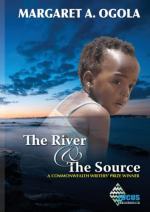|
This section contains 663 words (approx. 2 pages at 400 words per page) |

|
The River and the Source Summary & Study Guide Description
The River and the Source Summary & Study Guide includes comprehensive information and analysis to help you understand the book. This study guide contains the following sections:
This detailed literature summary also contains Quotes and a Free Quiz on The River and the Source by Margaret A. Ogola.
The following version of this book was used to create the guide: Ogala, Margaret. The River and the Source. Focus Publications, 2022.
The River and the Source traces four generations of Kenyan women through over a hundred years of their country's history. It begins around the year 1870 when Akoko, daughter of Chief Odero Gogni, is born in the Luo village of Yimbo, where life is largely dictated by traditional rules. Akoko marries Chief Owuor Kembo. Owuor delivers thirty cattle for her bride price, which is considered to be a shockingly large amount for the time period.
Owuor and Akoko are mostly happy together, but Akoko constantly has to push back on her in-laws' limited ideas of a woman's worth. Akoko has two songs, Obura and Owang, and one daughter, Nyabera. Both of her sons, as well as her husband, die suddenly and she struggles to find the strength to persevere. Breaking from tradition, she ultimately decides to leave her husband's compound and return to her ancestral home.
The story then follows Akoko's daughter, Nyabera. Nyabera also loses her husband and almost all of her children. Searching for hope and solace, she hears about a new religion brought by the white colonists, Christianity. She decides to leave her village and make a new life for herself at the Catholic mission. Eventually, she convinces her mother Akoko and her daughter, Awiti, and nephew, Owuor, to move in with her.
Awiti excels at the mission school. With the support of her mother and grandmother, she continues her education and eventually becomes a teacher, which is regarded as an unusual career path for a woman in her time. Her cousin Owuor forsakes his claim to the chiefdom in Sakwa and becomes a priest. Akoko accepts his decision, despite having fought so hard for his right to be chief. Owuor goes on to become a bishop.
Awiti, who takes the name Elizabeth after going to college, meets Mark, a Luo man from the town of Seme, and the two begin a relationship. But before they can get married, Akoko passes away. After a period of mourning, Elizabeth and Mark marry and have seven children. Their marriage is largely harmonious, although Mark briefly has an affair while living outside of their hometown for work. During this time, Kenya gains independence from the British.
Elizabeth and Mark's first children are twins, Becky and Vera, who are complete opposites: Becky is beautiful and selfish while Vera is intelligent and motivated. Growing up, Vera is very loyal to her sister, until she eventually becomes tired of Becky's self-absorbed attitude. The sisters fight and are never fully able to repair their relationship. Vera heads off to university while Becky runs away from home to become a flight attendant. Becky shocks her family by marrying a white man, a pilot by the name of John Courtney. Vera decides to devote her life and work to religion. She joins the Catholic institution Opus Dei and decides never to marry.
Aoro, Elizabeth and Mark's oldest son, heads off to medical school where he meets a woman named Wandia. The two of them are both highly motivated students and compete in class before falling in love and beginning to date. Shortly thereafter, they get married. The couple also experiences the rapid modernization of Kenya, as they balance their careers as doctors and their roles as parents. Wandia becomes close with the many strong women in Aoro's family, particularly Elizabeth, who takes an immediate liking to her.
Wandia and Aoro have four children together, and they also adopt Becky's two children after she dies of AIDS. Towards the end of the book, Aoro and the family celebrate Wandia receiving a doctoral degree in medicine—the first woman in Kenya to do so. Elizabeth dies shortly after and, at her funeral, the members of the family linger by her grave until, one by one, they are all pulled back into the immediate matters of their lives.
Read more from the Study Guide
|
This section contains 663 words (approx. 2 pages at 400 words per page) |

|



